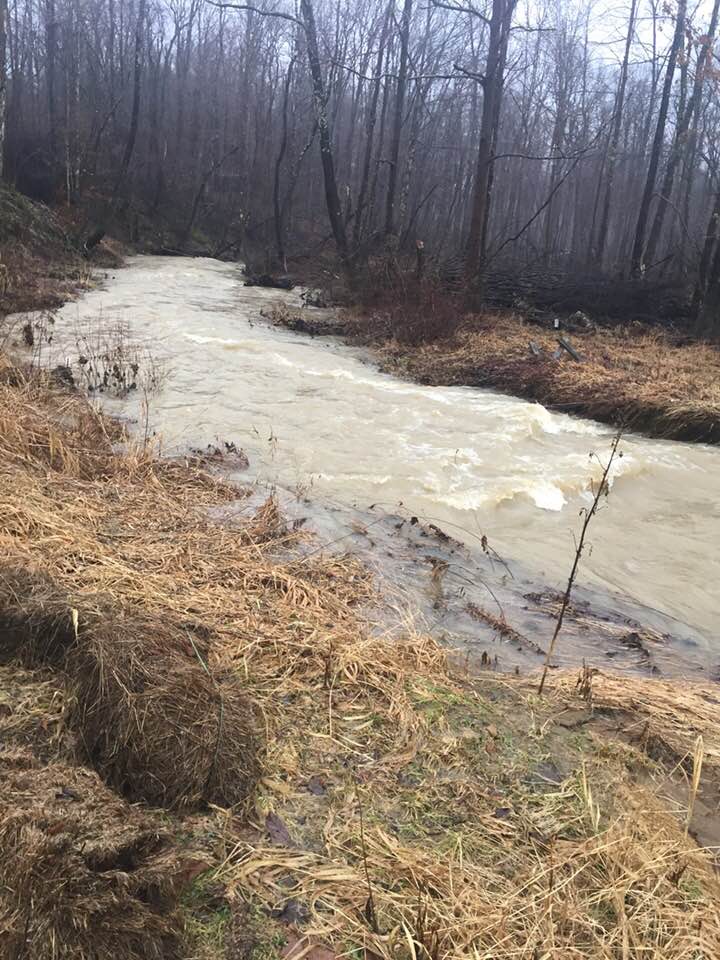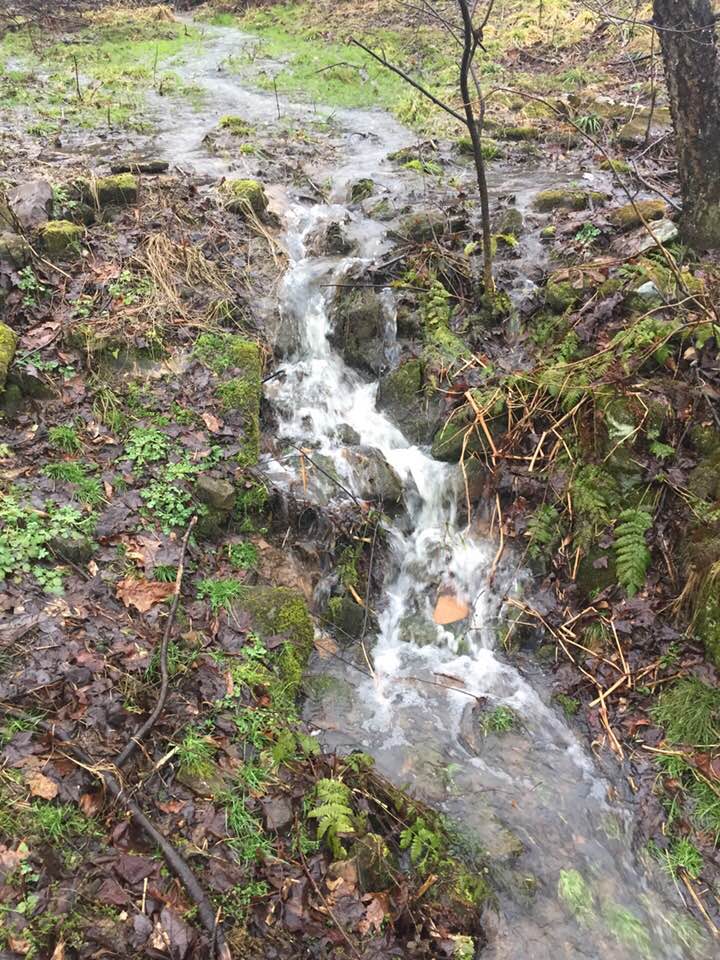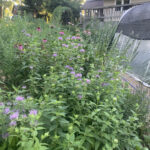
February is here, and it is all about flow. With the accelerating pace of climate change, February becoming is the new March–the most dynamic, engaging, extreme of the months of the year. February is a month of transition. It’s a month where the ebb and flow of water, snow, rain, and ice are ever-present and ever-changing. It is a month where the weather apologizes to no one: it is simply raw, powerful, unchecked. Just this past week here in Western Pennsylvania, we had a 60-degree day where the maple sap was flowing, then we had two days of solid rain that caused major floods in the region, and then yesterday it was a very cold day with 3” of snow overnight with a low of 15 degrees. In fact, late winter often has this kind of dynamism rarely found in other times of year. Each day in late winter is radically different: a different mood, a different temperature, different visuals, different water levels, a completely different experience. The message is simple: adaptability, change, growth, and flow are required of us now. And with this message comes the challenge of managing our own adaptability, emotions, and the change that swirls around us.
This post is part of my “Diary of a land healer” series; once-a-month documentation of the healing process of the land here, where I live, for 2018. I offer photos, thoughts, and lessons from this landscape as it heals and regenerates as well as insights I have as I watch this process unfold. You can read my first entry in this series from January here, and a large number of earlier posts on land healing here
Flowing of the Land
These freezing and thawing cycles have encouraged many different kinds of flows upon the land. One such pattern of flow is from the trees themselves. Everyone knows of the famous sugar maple with her flowing sap that can be transformed into delicious syrup. However, Maple trees aren’t the only trees to have sap running in their inner cambium this time of year–most trees have flowing of sap, but only certain trees have a high enough sugar content to make tapping them for producing syrup worthwhile. We think this time of year, everything is still under the snow, but a single warm day encourages the rise of sap up from the roots and into the branches. These trees well up with pure telluric energy–the sap comes up from the roots, deep within the earth, and into the branches and trunk. The water that flows from many trees–Sycamore, Maple, Birch, Hickory, Walnut, and Butternut–is delicious to drink and offers a vitalizing quality that I have only found in fresh spring water right from the mountainside.

At Imbolc, I made offerings, spoke with the trees, and tapped six of them who gave me permission. Since that time, each day the weather is warm enough and the sap is running, I have visited the maples and have drank right from the tree, bringing in the vitalizing nywfre (a druid’s term for life force/vitalizing energy) into my body as a rejuvenating practice. It is incredible–fresh, cold, pure, and putting a spring in my step that is hard to otherwise describe.
This same powerful life force, this Nwyfre, will eventually spark the new beginnings of all of the life upon this landscape. Nywfre is the spark of life, the magic present in the land that allows healing to take place–the trees just start that process when the rest of the plants and roots are still waiting for the sun to return.
Of course, the excess sap will be put to good use as my friends and I boil it down to make syrup, a fine activity on a warm February day!
Flowing of the Stream

Flow is happening in so many other ways on this beautiful landscape. Given the dynamic nature of the flows of February, I have been paying attention to the stream, Penn Run, which flows behind my house at the bottom of my property. The ebb and flow of the waters come anew with each new day. Its amazing how a single day of rain, ice, or snow transforms the whole landscape and the whole edge of the creek. Just two days before, as is my regular custom, I put on my muck boots and waded across the tranquil stream, enjoying the peace that it offered. But as the floodwaters raged and the stream was several feet above its normal height, I stood respectfully from the shore and honored the power of flowing water on this brisk February day.
The floods this week were potent and powerful. If we had this precipitation even 10 or 20 years ago, we would have had 2 or more feet of snow, but because it has been so much warmer in February in the last few years, the snow has become rain, sleet, and ice. This is a change I am sad to have to adapt to, for it warns me of further changes to come.
Earlier this week, in the nearby town of Indiana, PA, where a number of my local friends live, so many have been sharing photos and stories of flooded basements and posting messages alerting people to the height and flood status of Mill Run, the stream frequently floods and that runs through the heart of the town. I am thankful right now that my house is at the top of a hill and the Penn Run creek is at the bottom. This is an important lesson: planting ourselves carefully in relationship to nature. If we haven’t done that—these floods bring terror and sleeplessness.
In our quest as humans to do whatever we want, to dominate nature, to tame her, we forget that in the end, when nature wants something, she takes it. As I stood earlier this week looking at the swollen and flooded stream, and heard stories of flooded and frozen basements, I’m glad to know that I’ve chosen to live somewhere where the path of an angry stream does not impact whether or not I have a home the next day.

It’s amazing how much of our lives and lands depend on cycles of things that are somewhat unpredictable. Like this weather. We know that floods will come, but we don’t know when. In less than 12 hours, the stream went from a children’s wading pool to the point where a whitewater kayaker would have a very good time. We think about the time between Imbolc and the Spring Equinox as a time of renewal and healing. Yet healing is characterized by this stream, the turbulence and raw force of it.
The Flowing of Emotion
The powerful transition of the stream from tranquil to flooded resonates deeply with me on an emotional level and asks me to recognize the power of currents of deep emotion. We often go through our lives like that tranquil stream, peaceful, quiet, serene, going to work and coming home, being in the regular rhythm of our lives. And suddenly, out of nowhere, something intense happens: a terrible loss, a tragedy, or an unexpected event that rattles us to the core. And that one thing sets us off on this raging journey of turbulent emotion.
Part of that time of healing and renewal is not denying what is inside, but embracing it and saying “I’m going to deal with this right now. I am going to let these emotions flow. I am going to let all of this wash away.” Water breaks away all that is false, all that is damaged, all that says to us “I can’t…” A good friend of mine, on the same day this creek was flooding, talked to me about a relationship that she cared deeply about and that was sadly ending. She spoke to me of all of these emotions that were inside of her and she was afraid to experience them. I told her she needed to be like this river, to let it flood, and let it flow. She did so, and the healing, the release, was powerful.

Yet, in the same way, that physical floods can bring terror to those who have planted themselves on flood plains, so too, can these deep emotions bring terror. It is scary to watch the rage of incredible emotions flowing through you–or another–like this frothing creek. It’s particularly terrifying to experience these kinds of emotions if you don’t know how to navigate such a strong current. The current threatens to take you down, and pull you under. And sometimes it can. But, if you have learned how to kayak and you have a worthy vessel or some other way of navigating it, it can be a tremendously beneficial experience for your life.
Because when the stream returns to normal, the banks are different. Everything is clear. Debris and detritus is gone, washed away, or buried under sand and silt to become fertile ground. These floods are exactly nature’s process for renewing the landscape and bringing in fertility. Just as the physical stream has to flood, we too have to be in that flooded, turbulent space for a time if we are going to be renewed. And if we can do this, can gain the benefits of the rich soil, the healing, and the joy that comes in those later summer months as the floodwaters recede and land is born anew.
But what I worry about, both for the land and humans is when we dam them up. We know what dams do to an ecosystem. And similarly, we know what damming up emotions do to our souls.
Renewal, in nature’s way, is not a clean process. It is not an easy process. It’s a process of thawing and releasing, of ice and slosh, its rain and ice and snow. It is a process of unexpected floods rebuilding nutrients along the shore. It’ss hard work. And the land here, in this beautiful February time, reminds us of this powerful lesson.
Flowing Anticipation

All across this land, I can see the buds on the trees singing, saying “we are almost ready.”
I can see the maples flowing and drink the sap water every day to rejuvenate myself. The maples wave their branches, getting ready to bud, and say “it is nearly time.”
I can see the land starting to green again, even the ferns left on the forest floor start to wake up and say “it is almost here.”
Before we can look to the promise of spring, we have to deal with late winter’s flows of intensity upon the land. These floods are the floods of renewal. We can’t stop them. We just simply have to learn to adapt and do the hard work of renewal.




Dams are very detrimental to the surround countryside. So to are levees that are built to protect fertile floodplain lands. But when we have major floods then those levees break and flood the flood plain with nutrients that at one time was natural during mostly spring floods.
I don’t live in a place with levees (only dams), but that makes a lot of sense that levees also would have such environmental impact. Think about the impact of our own “inner dams” we construct as well!
I didn’t link to it in the post, but there’s a lot of info out there on the negative aspects of dams, like this: https://www.internationalrivers.org/environmental-impacts-of-dams.
[…] via Diary of a Land Healer: February — The Druid’s Garden […]
You’re right about the difference in the days! It always amazes me how I can take the same hike a week or two apart in the winter and feel like I’m walking in an entirely different landscape – a dry brown day, a white snowscape, a misty, foggy day as the snow melts – the land can feel completely different. And it happens much faster than the leafing out in spring or the color change in autumn.
Thanks for the comment! I agree–the changes are the most drastic this time of year. I don’t get such an “extreme” vibe in Autumn…probably becuase the soil and land is still warm, so it helps regulate. But there is no such regulation in the late winter!
What a lovely post! I find your point about drinking maple water straight from the tree as being full of life (if I got the concept right). A nice and relaxing read!
Yes. I’m actually going to write more about that specific thing in my next post–so stay tuned! Thanks for the comment!
Living on the edge of wetland, I’ve been experiencing this each day too. Thanks for your inspiring words. Now I need to get out there and trim my perennials before the buds really begin!!!
Yes! It is a good time for pruning :). Thanks for the comment and for reading!
Reblogged this on Rattiesforeverworldpresscom.
Love your blog and have nominate you for the Liebster Award: https://pathsiwalk.com/2018/02/22/liebster-award-nomination/
kind of makes me look at winter and the ending of it in such a new light….i usually try to ignore the “unpleasant” times of year but perhaps i need to embrace them a whole lot more!! ty. you have a very gently writing voice. i enjoy your blog very much
Thank you, Terri! Each season has a lot to teach us, I think. February is certainly a powerful season–very dynamic and unpredictable. I would suggest simply getting out in it and seeing what it has to offer you :).